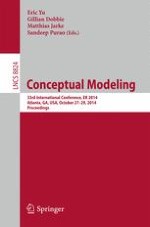This book constitutes the refereed proceedings of the 32nd International Conference on Conceptual Modeling, ER 2014, held in Atlanta, GA, USA. The 23 full and 15 short papers presented were carefully reviewed and selected from 80 submissions. Topics of interest presented and discussed in the conference span the entire spectrum of conceptual modeling including research and practice in areas such as: data on the web, unstructured data, uncertain and incomplete data, big data, graphs and networks, privacy and safety, database design, new modeling languages and applications, software concepts and strategies, patterns and narratives, data management for enterprise architecture, city and urban applications.
